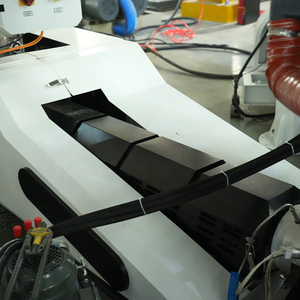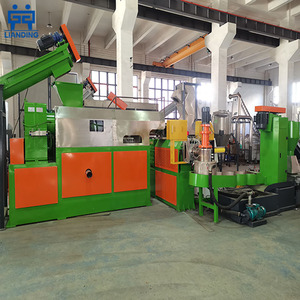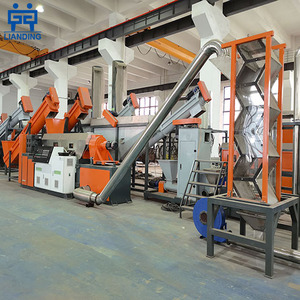
All categories
Featured selections
Trade Assurance
Buyer Central
Help Center
Get the app
Become a supplier

(1394 products available)




















The abc blown film extruder is a vital component in the manufacturing sector, specifically within the plastic and rubber processing industry. It is primarily used to produce blown film, a versatile material that finds applications in packaging, agriculture, and more. The abc blown film extruder consists of a series of interconnected machines that transform raw plastic pellets into thin, flexible film through a process of extrusion, inflation, and cooling. This production line is engineered to deliver high-quality films with precise thickness and width, ensuring consistency and reliability in the final product. As demand for efficient and sustainable packaging solutions grows, the abc blown film extruder continues to evolve, incorporating advanced technologies to enhance productivity and reduce environmental impact.
The abc blown film extruder is available in various configurations, each designed to meet specific production requirements. Common types include mono-layer, co-extrusion, and multi-layer lines. Mono-layer lines are the simplest, producing single-layer films suitable for basic packaging applications. Co-extrusion lines allow for the combination of different polymers, resulting in films with enhanced properties such as increased strength and barrier capabilities. Multi-layer lines, which can produce films with up to seven layers, offer superior performance in terms of durability, puncture resistance, and sealability, making them ideal for complex packaging needs. The choice of abc blown film extruder type depends on the desired film properties and the intended application, ensuring optimal production efficiency and quality.
The abc blown film extruder is equipped with various features that facilitate efficient and precise film production. Key components include the extruder, die, cooling ring, and winding station. The extruder melts the plastic pellets and pushes the molten material through the die, forming a tubular film. The cooling ring then cools and stabilizes the film as it is inflated to its final diameter. Advanced abc blown film extruder may incorporate features such as automatic thickness control, which ensures uniform film thickness, and gravimetric dosing systems for precise material blending. Additionally, some lines offer inline printing capabilities, enabling the direct application of logos and information onto the film. These features contribute to the versatility and adaptability of the abc blown film extruder, making it a valuable asset in film production.
The abc blown film extruder utilizes a range of materials to produce films with specific characteristics. Polyethylene is the most commonly used polymer, known for its flexibility, strength, and cost-effectiveness. Variants such as low-density polyethylene (LDPE) and linear low-density polyethylene (LLDPE) offer distinct advantages, including improved clarity and puncture resistance. Other materials used in the abc blown film extruder include polypropylene and polyamide, which provide enhanced barrier properties and heat resistance. Additives such as stabilizers, colorants, and slip agents are also incorporated to modify the film's properties and appearance. The choice of materials in the abc blown film extruder is crucial to achieving the desired film qualities, ensuring that the final product meets specific application requirements.
Operating the abc blown film extruder requires a thorough understanding of its components and processes. Before starting the production, ensure all equipment is properly calibrated and maintained. Load the plastic pellets into the extruder and set the temperature and extrusion speed according to the material specifications. Monitor the inflation process closely to maintain the desired film diameter and thickness. Regularly check the cooling system to prevent overheating and ensure consistent film quality. Utilize the winding station to carefully roll the finished film onto spools for storage or further processing. Safety procedures must be followed at all times to prevent accidents and ensure smooth operation. By adhering to these guidelines, the abc blown film extruder can be operated efficiently, maximizing productivity and minimizing waste.
Choosing the right abc blown film extruder is a critical decision that can significantly impact the efficiency and quality of film production. One of the essential factors to consider is the production capacity. Depending on your operational needs, you may require a line with a higher output to meet demand. Additionally, the type of film you intend to produce, whether mono-layer or multi-layer, will dictate the specifications required for the abc blown film extruder. Compatibility with different polymers is also crucial, as this will influence the versatility of the films produced. Assessing these factors ensures that the chosen production line aligns with your specific manufacturing objectives.
Another vital consideration is the technological features integrated into the abc blown film extruder. Advanced lines offer automatic thickness control and gravimetric dosing systems, which enhance precision and reduce waste. Inline printing capabilities can add value by allowing direct application of branding and information onto the film. Energy efficiency is also a significant aspect, as environmentally friendly production is increasingly important. Evaluating the technological aspects of the abc blown film extruder will help in selecting a line that not only meets current needs but also adapts to future advancements.
Multi-layer abc blown film extruder provides several advantages over mono-layer lines. They can produce films with enhanced properties, such as improved strength, barrier capabilities, and puncture resistance. These films are ideal for complex packaging applications that require superior durability and protection. Additionally, multi-layer lines allow for the combination of different polymers, enabling the creation of films tailored to specific requirements.
Automatic thickness control in abc blown film extruder ensures uniform film thickness throughout the production process. This feature minimizes material waste and enhances the consistency and quality of the final product. By maintaining precise control over film thickness, manufacturers can meet stringent specifications and reduce the likelihood of defects, ultimately improving productivity and reducing costs.
Yes, abc blown film extruder can be customized to accommodate various polymer types, including polyethylene, polypropylene, and polyamide. This customization is crucial for producing films with specific characteristics, such as flexibility, strength, and heat resistance. By selecting a production line with compatibility for multiple polymers, manufacturers can diversify their product offerings and meet diverse market demands.
Cooling systems are integral to the abc blown film extruder, as they stabilize the film during inflation and prevent overheating. Proper cooling ensures consistent film quality and prevents defects such as warping or irregular thickness. Advanced cooling technologies can enhance production efficiency and reduce energy consumption, making them a vital component in achieving optimal film properties.
Efficient operation of abc blown film extruder requires regular maintenance and calibration of equipment, as well as thorough training for operators. Monitoring the extrusion and inflation processes closely can help maintain desired film properties. Additionally, implementing safety protocols and adhering to operational guidelines minimizes downtime and maximizes productivity. By focusing on these operational aspects, businesses can optimize the performance of their production lines and reduce waste.